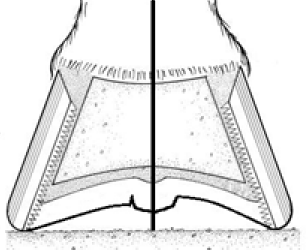One Foot For All Seasons? (9-8-06) Pete Ramey
Copyright 2006
[Note: This is a follow-up
to the previous article, "Understanding the Soles" available at
http://www.hoofrehab.com/HorsesSole.html. Please read the other
article first for clarity. Pete]
Important definition from previous article:
Collateral Grooves- The
"seam" between the sole and frog (also known as the collateral sulci or the frog/sole junction). They
are a significant landmark, because their distance from the external surface
to the corium surrounding the coffin bone and the lateral cartilages is
consistently around 7/16-inch (9mm) [except in the rare cases of previous
subsolar abscesses of the frog and sole coriums simultaneously, which can
push them farther away with retained false soles/frogs and fungal or
bacterial infections which can eat them deeper]. Given the concaved
shape of the coffin bone and lateral cartilages, the higher the collateral
grooves are lifted off the ground by the outer perimeter of sole, the more
sole thickness there is at this outer perimeter. The collateral grooves can
accurately be used to judge sole thickness anywhere in the outer perimeter
of sole adjacent to the white line by visualizing how high this outer
perimeter of sole would lift the collateral grooves above a flat ground
surface.
Note:
The prospect of supporting P3 through the sole often seems
impossible and generally foreign to many farriers. They know
from experience that if you shoe with sole pressure, the corium
will bruise and abscess. But understand the difference between
constant pressure and pressure and release. P3 can
only be truly supported through the sole when the pressure to
the sole's corium is being released during flight. This is one
of the primary reasons I favor hoof boots with padded insoles,
rather than shoeing systems with impression material for
laminitic horses.
When many people first study the deep solar
concavity of most desert feral hooves and healthy domestic
hooves, they get the idea that the sole and frog are passive –
lifted off the ground by the bowl-shaped bottom of the foot.
This is not true.
The problem is, many farriers and trimmers
were incorrectly taught to evaluate and think about hooves while
the horse is standing square on concrete, with less thought
given to the hoof and limb mechanics in motion or the terrain
the horse lives and works on. In fact, when a horse is on the
varied terrain – deep, soft footing and/or rocky footing that
forges these deeply concaved soles, everything that casts a
shadow bears weight. In the front half of the foot, given the
larger surface area, even a deeply concaved sole bears more
weight than the much smaller surface area of the hoof wall
around the periphery. This is very safe, natural and comfortable
for horses if adequate sole thickness and callusing are present
in the hoof.
Study of healthy, sound horses and recent research from Robert Bowker VMD, PhD suggests that the horse was never intended to “hang” from the laminae as most of us were originally taught. Direct support of the coffin bone through the sole is essential to preventing unnatural, excess stress on the laminae that can contribute to lamellar failure. The deeply concaved soles provide this support when the horse is working on rocks, soft dirt and grass as the foot sinks into the varied terrain.

Photo A: Quarter Horse front hoof - pasture/arena
This deeply concaved front foot
[pre-maintenance trim] functions beautifully for this horse in the yielding
terrain he lives and works on: Unparalleled traction, soundness and
function. Aside from a shedding frog that should probably be peeled away,
the foot has almost perfectly maintained itself for its terrain for the last
six weeks; it doesn't even need a trim. If you put the same foot on hard
flat terrain, however, it would be all wrong:
Suddenly there would be no natural support of P3 through the sole, no much-needed frog pressure and the bars would be completely out of functional use. What would happen next? This foot would immediately start to try to adapt into a "flat terrain foot." with much needed sole, frog and bar support on that terrain.
But what if the same horse routinely lives
and works on perfectly flat surfaces? Then our natural P3
support is missing and that same deeply concaved foot will cause
peripheral loading. The horse is right back to hanging
all of his weight unnaturally from the laminae. Healthy laminae are strong enough
to withstand this occasionally, but the repeated insult will
cause damage or failure of the hoof wall/coffin bone attachment.
It is my opinion that the swelling caused by concussion on a
hard surface that is commonly blamed for road founder
(mechanical damage to the laminae) is not the culprit at all;
instead it is the peripheral loading that usually results from a
hard, flat surface. The horse simply needs sole
pressure/support.
The expansion of the hoof capsule on hard
impact is essential to the horse for both energy dissipation
(much like the flexion of your car tires) and for healthy
circulation [Bowker ‘99]. The primary force that causes this
necessary expansion is the weight of the horse descending onto
the concaved sole, drawing it out flat, thus pushing the walls
apart on impact. To my knowledge, no one has ever actually
studied how much hoof expansion is necessary or natural, but my
personal observations leave me suspecting most hooves should
expand about ¼- to ½-inch on hard impact. To achieve this, the
arc of the sole should be able to flatten about ¼-inch
vertically on hard impact as well.
On gravelly surfaces or soft terrain that
the outer perimeter of the hoof can sink into, the "naturally"
deep (1/2-inch to 3/4-inch) vault of solar concavity is
necessary for this ¼-inch of sole flattening to occur; causing
expansion of the hoof capsule. However on a hard, flat surface
¼-inch of total solar concavity may be all that is needed and
having more solar concavity can actually deprive the P3 of
necessary support.
In the real world (if you have grown
well-attached hoof walls), achieving the correct amount of solar
concavity is usually pretty easy if the horse is moving on the
same type of terrain 24 hours a day. The foot will do it for you
if you allow it. If the horse is always on a hard flat surface,
the inner part of the sole (closer to the frog) will fill in,
and the ¼-inch of total solar concavity will usually wear into
the foot, provided the walls are not allowed to overgrow and the
horse has freedom to move.
If the horse is, instead, always moving on a yielding or rocky surface, the soles will tend to callus into a deeply concaved shape with uniform sole thickness over the coffin bones and lateral cartilages, mirroring the individual's coffin bone shape. I think either way, in each terrain type, the sole is seeking its ability to provide the ¼-inch of flattening (at impact) that is so critical to hoof expansion, while also seeking a critical need for this flattening to “bottom out” so that the coffin bone is supported and excess shear stress does not damage the laminae.
Feral front hoof- hard terrain
Whether the sole has callused into a
deeply concaved shape for rocky or yielding terrain, or filled into a
flatter shape for hard, flat terrain, the collateral grooves (seam between
the frog and sole) should be lifted 5/8” to 3/4” off the ground by the outer
perimeter of sole adjacent to the white line. This ensures you have adequate
sole thickness to protect the internal structures. (Please read
Understanding the Soles for clarification of reading sole depth using
the collateral grooves.)

Hard, flat terrain Yielding terrain
If you cross-section a hoof an inch behind the apex of the frog you get a clear view of what the collateral grooves mean to sole depth in flat terrain feet vs. yielding terrain feet. The right side of this drawing shows the natural adaptation to yielding or rocky terrain. The left side of the drawing shows the "right foot" for hard, unyielding terrain.
In both feet, the collateral grooves are lifted 1/2 to 3/4 inch from a flat plane by adequate sole thickness in the outer perimeter, and both sole types offer both P3 support and hoof flexion in their given terrain.
Photo C: Feral horse - hard terrain
This wild foot has shaped itself
"right" for hard, flat terrain. It has a 3/4-inch deep collateral groove
(total height off a flat surface); indicating optimum sole thickness in the
outer band of sole so important for protection from sensitivity and
bruising, but the sole's actual "vault" is only 1/4-inch deep, allowing
support on a flat, hard surface at peak expansion. Also note the frog can
receive pressure and aid in the dissipation of energy and support, even on a
flat, hard surface.
If you really spend some time pondering the forces on everything, the ratio of pressure to the frog, bars, sole and walls are probably identical in this hoof and the hoof in Photo A, given the difference in terrain! Each part of the foot is seeking a particular percentage of the load. The differences in terrain create completely different hoof forms that are performing the same function!
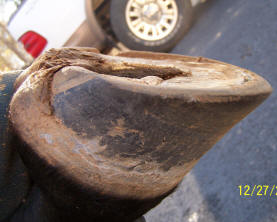
Thoroughbred, just pulled shoes, soles were thinned by previous farrier.
Compare this hoof at left to the
feral horse in Photo C: Similar "flat" sole and protruding frog. The big
difference is there is almost no sole under the outer perimeter of P3 to
lift the collateral groove off the ground. The bottom of the collateral
groove is almost the lowest thing on the foot, meaning the sole is literally
paper thin! Keep this horse off rocks and hard terrain until more sole can
be built, and definitely leave your knife in your pocket.
The picture at right shows the same
foot 5 months later as healthy callused sole is building in. The outer
perimeter of sole would now lift the collateral groove 1/2 inch off the
ground.
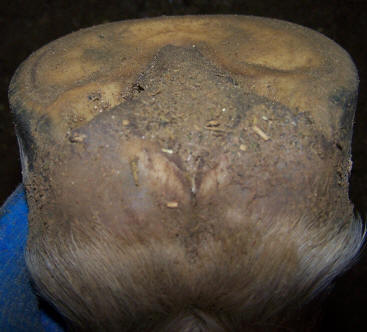
Quarter Horse front hoof - "concrete" frozen paddock
Quarter Horse pre and post 5 week
trim (same photo). This foot has shaped itself perfectly for the hard-frozen
Ohio paddock it calls home. The sole's total arch is only 1/4 inch, but the
very bottom of the collateral grooves are lifted 5/8+ inch of the ground by
the outer band of densely callused sole, indicating adequate sole thickness
at the outer perimeter.
Note the less sloping mustang roll
necessary when the foot can't sink into its terrain and that there is frog,
sole and bar support; even on the flat surface. The foot can flatten and
expand, but still "bottom out" for support.
The best thing a trimmer can do to
this foot is nothing, even if the owner just flew you 600 miles to do a
maintenance trim on the horse (as was the case here). Horse owners want to
pay for equine performance, not your sweat.
“If someone were cutting half of the sole from
your foot every 4-6 weeks, no one would wonder why you were lame.
It would be obvious. In the horse world, this simple
“common sense” is very uncommon. Most professionals can list a dozen reasons
why they think routinely cutting sole and frog off the horse offers
protection, function and soundness. I’ll sugar-coat this as politely as I
can: In almost every case they are wrong.” Pete Ramey
Our problems begin when we suddenly switch
the horse from one terrain to the other. For instance, in many
areas the correct foot for winter is all wrong for summer. If
your pasture or paddocks are yielding in the summer, but frozen
solid in the winter, it is healthy to allow your horse to wear
completely different feet during the “hard” times in winter. Let
the center of the soles “fill in” to a flatter state. If you try
to force your hooves to be deeply concaved, you will probably
cause the damage, stress and distal descent of P3 associated
with peripheral loading.
When springtime rolls around and the ground
softens, it is usually best to help the horse adapt to a more
concaved summer foot by taking out the retained sole adjacent to
the frog, paralleling the inner structures and respecting
natural sole thickness. The horse will usually start to try to
'let go' of this excess, indicating it is time to help it come
out with your tools. Look carefully for and respect the true
healthy sole plane that will usually be lying underneath the
exfoliating material. Generally speaking, you only have to do it
one time, then natural wear and callusing will take over for
you. Please be careful, here. It is much better to do too little
or nothing to the soles than it is to do too much. Again, the
previous article,
http://www.hoofrehab.com/HorsesSole.html will
help you do this correctly. After you do this “cleaning out,”
recognize that the healthy sole underneath is a natural
thickness, but is probably not well callused. There is a big
difference between a 5/8-inch-thick sole and a 5/8-inch-thick
callused sole! Use hoof boots for rocky terrain or when you add
the weight of a rider until densely callused sole is achieved.
It is very important not to overdo it. When
in doubt about the sole or frog; leave them alone. I strongly
believe that the most common cause of hoof tenderness is
constant micromanagement of the sole and frog, so I'm not
suggesting you run out and change the feet every time the
weather changes. Instead you should accept, understand and
respect the need for these different adaptations to terrain
throughout the year. If you understand the need, when the
terrain changes you will be able to notice the hoof trying to
change on its own; you are just there to help it along,
because domestic horses don't typically move enough to do a
complete job in a reasonable time.
In other regions it works in the exact
opposite way. Soft mud and wet pastures in winter turn to dry,
baked ground in summer. Other people deal with soft snow in
winter and hard ground in summer…… The list goes on, but the
point is, wherever we live we need to listen to the hooves and
think about the mechanics in the living/working terrain rather
than only in the wash rack on trim-day.
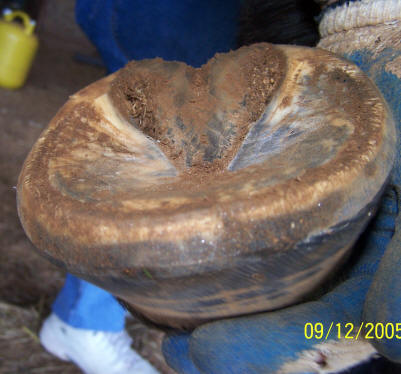
Tennessee Walker front hoof - pasture/arena
When it is time
for change to yielding terrain, it is often correct to "clean out" the
retained sole and excess frog. Note that the outer band of sole adjacent to
the white line was untouched. Remember everything that casts a shadow bears
weight in yielding terrain – you aren't making
the walls, sole bars or frog passive. Don't thin the sole beyond 5/8-inch
and don't repeat this trim over and over; areas of sole that "pop back"
quickly are needed, whether you understand why or not! Use hoof boots for
riding on rocky terrain until the newly exposed sole, bar and frog are
heavily callused.
Another question that often comes up
is, “What if the riding terrain is wildly different from the
living terrain?” For the very healthiest answer, I’ll quote Dr.
Bowker again, “Bed your horse in the terrain you wish to ride.”
If you can’t provide that, the next best option is usually to
trim for comfort and function in the living terrain and boot for
the riding terrain. If the soles are packed into a deeply
concaved shape, I like to use dense foam insoles in the boots so
the foot isn’t peripherally loaded by the boot floor.
If the horse is worked enough, the foot will adapt to the work
conditions instead of the living conditions, even if the horse
actually spending more time loafing around in the pasture. It is
a question of miles, not time. For example: hard-working
barefoot carriage horses and mounted patrol horses tend to
“want” the flatter, thicker “concrete hooves” that mirror their
working conditions. I allow it, even encourage it. I did worry
in the past that these hooves might experience problems because
they were too flat and too hard to function properly in the
pasture, but I’ve yet to see any real-world problems occur that
suggested there was inadequate circulation or hoof function.
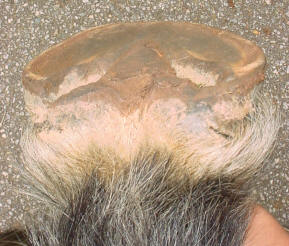
Both of these horses live on similar pastures, but the
left photo shows a front hoof forged by hard work on gravel roads. The right
photo shows a hoof forged by hard work on asphalt.
Can you see that frog, sole, bar and
wall pressure might be the same in both hooves, given the
different terrain?
Since the collateral grooves tend to be 7/16” (9mm) away
from the corium, if you concave the sole all the way to the
bottom of the collateral groove around the apex of the frog,
you will have cut the sole too thin (right side of drawing).
In order for the entire sole to be of adequate (5/8”-15mm)
thickness (much needed for safety and soundness), there
needs to be a 1/4-3/8” vertical dropoff into the
collateral grooves adjacent to the frog (left side of
drawing). Note that the collateral groove
heights-off-the-ground are the same on both sides, but the
left side has a much thicker sole.

The same reasoning is important when considering the sole
ridges that tend to pop up along the sides of the frog. On
the right side of the photo, the sole ridge is simply the
horse growing adequate sole thickness in that spot – leave
it alone, and hope that adequate thickness spreads to the
rest of the sole. Look for that 1/4” dropoff into the
collateral groove. On the left side of the photo, there is a
1/2” dropoff into the collateral groove – this ridge
of sole has formed on top of an adequately thick sole. It
might be appropriate to trim this ridge off so that the
dropoff is only 1/4” deep, though do consider that it might
also be a terrain adaption as discussed above.


